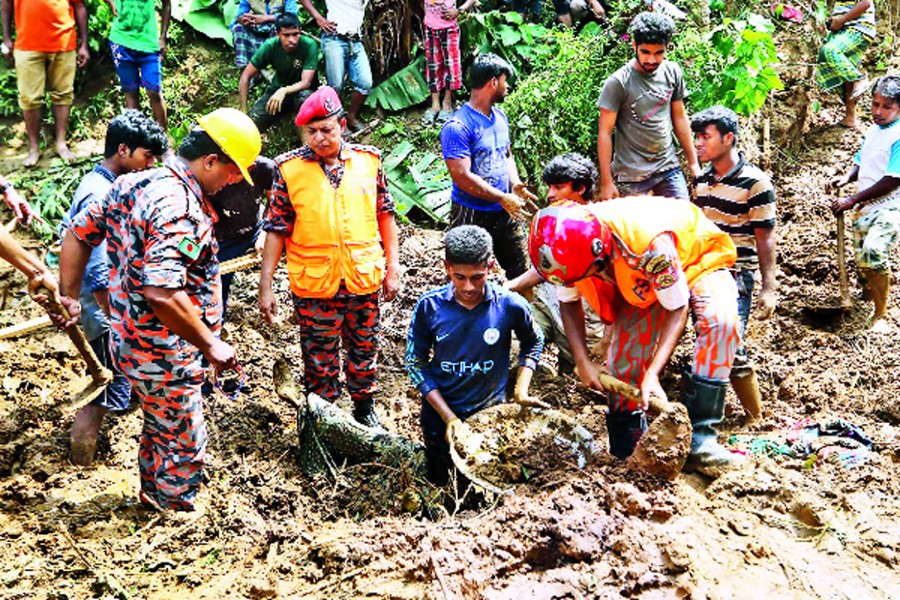 Rescue workers try to recover a dead body after a landslide in Rangamati in June last. — AFP
Rescue workers try to recover a dead body after a landslide in Rangamati in June last. — AFP  A few months ago, the worst landslides in the history of Bangladesh killed over 160 people in the Chittagong Hill Tracts (CHT) region. While the densely populated country is no stranger to natural disasters, the magnitude of this event was unprecedented, and deserved an in-depth study for remedial measures.
A few months ago, the worst landslides in the history of Bangladesh killed over 160 people in the Chittagong Hill Tracts (CHT) region. While the densely populated country is no stranger to natural disasters, the magnitude of this event was unprecedented, and deserved an in-depth study for remedial measures.
"Not only in the CHT but this is probably the most catastrophic landslide we have seen in all of Asia in a long time," said Mr. Rezaul Karim, Executive Member of Red Crescent Society, Rangamati. He also added that around 12,500 families were partially affected by the landslide and accompanying floods, while 3,000 families lost everything.
What caused this disaster? : While intense torrential downpour was the triggering factor, the causes for the landslides are mostly man-made, according to experts.
Pressure on land is seen as one of cardinal causes: The various ethnic groups who inhabit the Hill Tracts practice a form of slash -- and -- burn cultivation known as 'jhum'. With population increase due to an influx of Bengali migrants in the hilly areas, jhum land is decreasing, and as a result, the (cultivation) gap period has decreased to three years from around 15-20 years. The resulting stress on soil and erosion is also increasing the likelihood of landslides, according to Uttam Kumar Chowdhury, Coordinator of "Sustainable Initiatives for Development Reformation" project of Manusher Jonno Foundation, an NGO.
Clearing forests also backfires in a revenge action: Experts have cited the removal of tree cover as a primary reason for the landslides. Bangladesh's hills are alluvial, made mostly of loose sand and soil, with the trees holding the soil together. With indiscriminate tree felling and long-term deforestation, there is nothing to stem the flow of rain down the slope of the hills, resulting in greater damage. However, the wrong kind of a forestation can exacerbate the situation, as environmentalist Philip Gain points out.
"Areas with Shegun (Teak) plantations have collapsed because these trees remove the topsoil," he says, adding that natural forest cover is the best for keeping the soil intact.
Now the focus turn on Hill cutting: Unabated removal of large chunks from hills is compromising their structural integrity, making landslides more likely. Gain said that most of the houses that have been affected by the landslides had been built illegally on hills by earth cutting. The construction methods used by Bengali settlers -- cutting down trees and terraces into the mountains -- are riskier than that of the indigenous population, who build stilt-based homes that inflict less damage to the hills.
The consequences: While the casualties made headlines in June, the landslides also have long-term consequences on the affected areas that deserve equal attention.
"The agricultural lands are not cultivable now as the soil has collapsed on water," said Ukheching Chakma of Maleya Foundation, a local NGO working for indigenous people. The layer left bare after the disaster is mostly stone. "We don't know how many years it would take to get these lands back to being cultivable," he added.
Permanent rehabilitation of the victims is another major issue. Most of the people who lost their homes were moved to rehabilitation centres temporarily. After three months of operation, the centres closed recently. But while some of the people have been able to reconstruct their houses and return, others have had to take shelter in their relatives' homes, working as day labourers. According to Mr. Karim of Red Crescent, using schools as a shelter for the long-term is not a viable solution, as it makes it difficult to conduct regular classes there. But the high rent in Rangamati, which Karim says is comparable to Dhaka, also makes it difficult for the victims to rent a room to live in.
Some of the victims have received monetary aid, but they cite it as grossly inadequate.
"You can't build a house with 15,000 taka," said Durbacchamori Chakma, a resident of Ulochara para of Rangamati who lost his abode during the disaster, adding that they need long-term support from the government. "If we received 40-50 thousand taka, we could start a business and, maybe, rebuild our houses and our lives," he said.
However, the government resources of this disaster-prone country are stretched thin.
"In our Upazila, there are only 40 bundles of dheu tin (roof-construction material) and hundreds of affected families. Who do I give them to?" says Arun Chakma, Upazila chairman of Rangamati Sadar. He also pointed out that most of the aid that is given from non-governmental organizations and privately is usually centered around the municipal area, very little reaching the remote unions that are the most vulnerable.
The task of rehabilitation is further complicated by the land shortage in Rangamati. "We thought we would build new houses for them, but there is not much plain land left to do that," Mr. Rezaul Karim of Red Crescent said.
The way forward: For effective relief and recovery efforts in the future, communications infrastructure need an overhaul. Due to road blockages, fire brigade couldn't come from Chittagong to the affected areas, said Upazila Chairman Arun Chakma, warning that this is an issue that needs to be addressed immediately as he foresees more landslides in the future.
The process of classification of victims also needs to be streamlined with more coordination centrally at the early stage. Ujjal Chakma, another victim of the landslides from Rangamati, said that some victims such as him whose houses were destroyed entirely were added to the "at risk" category rather than the "victim" category, which precluded them from receiving aid. Moreover, the process of creating a list of the victims lacks coordination, with different organizations creating their separate lists, which resulted in some victims receiving aid multiple times and others receiving none.
However, the situation also calls for more long-term interventions that focus beyond relief and recovery.
"When a catastrophe strikes and people die, a sentiment grows, but it is quickly forgotten," said Dhaka University Geography and Environment Professor M Shahidul Islam, who was actively involved in rehabilitation efforts after the 2007 landslides in Bangladesh.
Islam suggests that a database of mountains needs to be created, and a national cell set up that will solely be responsible for overseeing drives against hill cutting.
He also feels that vulnerable areas should be identified pre-emptively via geological surveys and people living there either need to be provided engineering protection or moved elsewhere.
However, Islam is well aware that moving people in the Chittagong Hill Tracts is much more complicated than anywhere else in the country. The collective property ownership system of ethnic minorities, the three-tier governance process in the CHT unlike the rest of the nation, disputes over land ownership with Bengali settlers, illegal occupation of lands etc., mean that many people are staunchly opposed to leaving their lands despite risks of losing the property.
"The CHT Land Commission needs to be made more effective in addressing the ownership disputes and dispossession of lands of the indigenous people," Islam says, "It's time to take some major steps at the policy level."
Sohara Mehroze Shachi is a freelance
journalist and curator of Dhaka
hub of Global Shapers Community.
© 2024 - All Rights with The Financial Express
